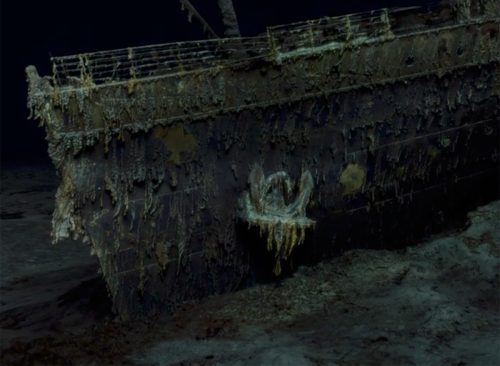New 3D Scan of Titanic May Reveal Bombshell Clues About Sinking
New scans have penetrated decades of mud.

The infamous wreckage of the Titanic has sat on the ocean floor for more than a century, and numerous studies and dramatic recountings of its story suggest that we know all there is to know about the epic disaster. But new 3D technology argues that isn't so—and, in fact, may have uncovered new information about what caused the ocean liner to sink. New scans have penetrated decades of mud and debris to provide a new view of the ship, which rests 12,500 feet beneath the surface of the Atlantic Ocean, about 400 miles south of Newfoundland, Canada.
1
More Than 700,000 Images

As part of the new initiative, photographers have taken more than 700,000 pictures, capturing ever millimeter of the structure. This has allowed an exact 3D reconstruction, called a "digital twin", to be created by research scientists experienced in geotechnical surveys and deep water exploration, the UK Telegraph reports. The new scans show that the ship's bow was preserved by the icy water, but the stern was destroyed as it sank into the mud of the ocean floor.
2
The Project

The scanning took place over six weeks in 2022 and took hundreds of thousands of photos despite bad weather and technical complications. The photographers found the site of the grand staircase, made famous in the movie Titanic, and even encountered champagne bottles and the serial number of a propeller, the Washington Post reports. Previous images of the Titanic—discovered by oceanographer Robert Ballard and others in 1985—"have been limited by low light levels and poor image quality," the news outlet says.
3
Watershed Work

"Over the course of the Titanic project the volume of data that we acquired was enormous – around 715,000 images and some 16 terabytes of data," said Richard Parkinson, founder of Magellan, a deep-sea mapping company. "We believe that this data is approximately ten times larger than any underwater 3D model that's ever been attempted before."
4
"The Titanic As No One Had Ever Seen It Before"

"What we've created is a highly accurate photorealistic 3D model of the wreck," said Gerhard Seiffert, a 3D imaging specialist. "Previously footage has only allowed you to see one small area of the wreck at a time." He added: "This model will allow people to zoom out and to look at the entire thing for the first time. So, by capturing this 3D model, what we're able to do is visualize the wreck in a completely new way, there's all kinds of amazing small little details that you can see. This is the Titanic as no one had ever seen it before."
5
"True Game Changer"

Parks Stephenson, an expert who has been researching the Titanic for two decades, told the Telegraph this development was "a true game changer" that may shed light on what really happened in the disaster, including exactly where ice struck the ship. "I'm seeing details that none of us have ever seen before and this allows me to build upon everything that we have learned to date and see the wreck in a new light," he said. "We've got actual data that engineers can take to examine the true mechanics behind the breakup and the sinking and thereby get even closer to the true story of the Titanic disaster. For the next generation of Titanic exploration, research and analysis, this is the beginning of a new chapter."














